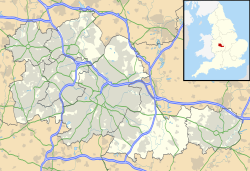| Netherton Reservoir | |
|---|---|
 Looking north towards Netherton Hill | |
| Location | Netherton, West Midlands |
| Coordinates | 52°29′05″N2°05′39″W / 52.4846°N 2.0942°W |
| Lake type | reservoir |
| Primary inflows | Surface runoff |
| Primary outflows | via culvert to Dudley Canal |
| Catchment area | 60,000 m2 (650,000 sq ft) |
| Managing agency | Dudley Metropolitan Borough Council |
| Built | 1835-38 |
| Max. length | 265 m (869 ft) |
| Max. width | 250 m (820 ft) |
| Surface area | 60,000 m2 (650,000 sq ft) |
| Average depth | 8 m (26 ft) |
| Max. depth | 15 m (49 ft) |
| Water volume | 625,000 m3 (22,100,000 cu ft) |
| Shore length1 | 0.9 km (0.56 mi) |
| Surface elevation | 138 m (453 ft) |
| 1 Shore length is not a well-defined measure. | |
Netherton Reservoir - otherwise known as Lodge Farm Reservoir or locally known as The Rezza is a canal feeder reservoir in the Netherton district of Dudley, England. It opened in 1838, and is now used for watersports, as well as supplying water to the canal system.
Contents
The Dudley Canal Line No 2 followed a circuitous route, but in the 1830s Thomas Brewin was responsible for building a more direct route. The total length of the new canal, which opened in 1838, was about 400 yards (370 m), which included a 75-yard (69 m) tunnel, known as Brewin's Tunnel. The new route enabled a reservoir to be built over the old course of the canal, together with a steam-powered pumping engine. The tunnel did not last long, as it was opened out in 1858, necessitating the construction of a bridge to carry the lane which had previously crossed over the top of the tunnel. [1] The bridge is now called High Bridge (locally known as the "Sounding Bridge"), and the lane is called Highbridge Road. [2] [3]
The reservoir, which was built between 1835 and 1838, acted as a storage reservoir, so that when water was plentiful, as a result of rain, it could be pumped from the canal into the reservoir, and then released back into the canal through sluices near the tunnel when it was required. The engine was installed in 1840, and drove a scoop wheel. A cottage was provided for the sluice keeper. [4]
With the nationalisation of the canals in 1948, ownership of the reservoir passed from the Birmingham Canal Navigations, with whom the Dudley Canal had amalgamated in 1846, [5] to British Waterways. They sold it to Dudley Metropolitan Borough Council in 1966, who wanted to improve the leisure facilities within their area, and have since developed it for watersports, [4] although it still supplies water to the canal. [3]

